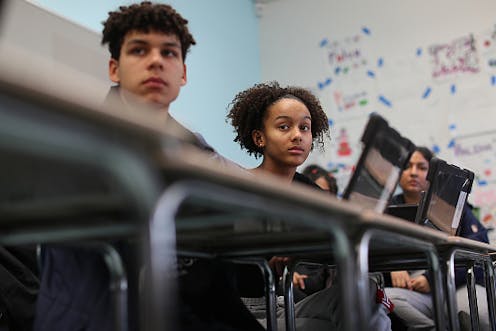'Telepresence' can help bring advanced courses to schools that don't offer them
If a high school doesn't offer advanced coursework, having students take such a class remotely offers a promising alternative.

The Research Brief is a short take on interesting academic work.
The big idea
In schools where students want to take an advanced course that the school doesn’t offer, the telepresence model, which enables students in one school to use videoconferencing to take a course offered at another school, is an effective alternative that can keep students learning and engaged.
To reach this conclusion, which we published in a recent study, we looked at the use of the telepresence model at the public school system in Milwaukee. Beyond videoconferencing equipment, the telepresence model uses smartboards, an online learning platform, and video and text chat to bring students from schools throughout the city together into a virtual classroom.
Why it matters
Using telepresence enables schools to offer students advanced courses they wouldn’t otherwise be able to take. By providing more students with advanced coursework, it makes them more ready for college.
Telepresence can be particularly useful in school districts that don’t offer many Advanced Placement courses, more commonly known as AP courses. While approximately 92% of schools offer AP or International Baccalaureate courses, which are college-level courses that students can take in high school, research has found that AP courses are offered less frequently at schools that serve primarily low-income students of color.
In our research, we found telepresence allowed students attending 10 schools across Milwaukee to learn in a single virtual classroom. Teachers facilitated learning from a classroom at the host high school. Normally, there has to be an minimum number of students enrolled in an advanced course in order for a school to justify offering the course. Telepresence bypasses the need for an individual school to meet this requirement.
The approach appears to be effective. We found that participating students enrolled in one to two more AP courses than otherwise predicted. Students participating remotely also attended three more days of school than in prior school years. Students participating at both the host and remote schools scored two to three points higher on the ACT college entrance exam than students from similar backgrounds and of similar academic standing. In a survey of 499 students, 93% agreed or strongly agreed that the teacher encouraged them to participate in class. Eighty-six percent of the students agreed or strongly agreed that the telepresence technology provided many chances for student input throughout the course.
A teaching assistant at each remote site ensured engagement by helping the teacher get a read on whether students were paying attention. In some instances, students in a particular class took field trips or did weekend study sessions together.
What’s next
These findings show that you can keep students engaged and learning together even when they are not located in the same classroom or even the same school.
This will be particularly important now and in the future since the recent COVID-19 crisis pushed many of America’s school to transition to virtual learning – something that is likely to continue in various forms into the coming school year and beyond. For this reason, educators need to know what approaches are effective.
Telepresence by itself is not what makes it work. For instance, teachers stressed the need to refer to remote classmates by name in order to make the social atmosphere more like a regular classroom. Teachers also facilitated interaction by using text and video chat for group work. Teachers shared these successful strategies with each other online and through regular meetings.
The coming school year provides a chance to study the use of telepresence across more classrooms. There may also be the potential for partnerships between school districts in, say, rural and urban districts, to ensure that more students have access to quality advanced courses.
[You’re smart and curious about the world. So are The Conversation’s authors and editors. You can get our highlights each weekend.]
Jennifer Darling-Aduana received funding from the William T. Grant Foundation to support this research.
Carolyn Heinrich received funding from the William T. Grant Foundation to support this research.
Read These Next
Are tomorrow’s engineers ready to face AI’s ethical challenges?
Ethics is often neglected in engineering education, two researchers write, despite mounting questions…
Caring for older Americans’ teeth and gums is essential, but Medicare generally doesn’t cover that c
There is ample evidence that poor oral health plays a role in many chronic diseases.
Getting a good night’s rest is vital for neurodiverse children – pediatric sleep experts explain why
Sleep habits can be improved by making shifts in both daytime and evening routines.



